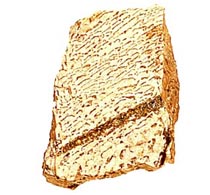DK Earth: Rocks
Earth’s crust is made of rock, and rock is made of natural substances called MINERALS. There are three main types of rock—sedimentary, igneous, and metamorphic rock. Each type is produced in different ways. The oldest rocks on Earth were formed about 3.8 billion years ago.
The rocks that form Earth’s crust are continually destroyed and remade in an endless process called the rock cycle. Rock is formed by melting; by cooling and solidifying; by changing through heat and pressure; by weathering and erosion; and by compression and cementation.
Igneous rocks form when magma (molten rock) rises from deep underground and cools and solidifies at or near Earth’s surface. Igneous rock that forms under the ground may later reach the surface because of geological upheaval. It may also be exposed as the rocks above are worn away.
Sedimentary rocks are made of fine rock particles that have been worn away and then carried by rivers, glaciers, or the wind and collect in lakes and oceans. The tiny fragments are then compressed (squashed) and cemented together to form sedimentary rock in a process called lithification.
Metamorphic rocks are formed when existing rocks are changed underground by great heat or pressure, or both. When volcanoes erupt and when mountains are formed by the movement of Earth’s tectonic plates, rocks are heated and squeezed. The minerals in the rocks are then changed, forming metamorphic rocks.
Rocks are made of natural, nonliving chemical substances called minerals. Some rocks contain only one mineral. For example, marble is made of the white mineral calcite. Most rocks, however, contain CRYSTALS of several different minerals.
Some of the most valuable minerals are ores— minerals that contain metals such as gold, iron, and aluminum. Of these, gold is the most precious because it is soft and easy to work and does not tarnish. Other minerals are prized as GEMSTONES. Fossil fuels, such as coal, produce energy. Minerals such as sulfur and mica are used in industry. Granite and sandstone are used as building stones.
Crystals are solid, regular, geometric shapes formed by most minerals. They have smooth surfaces (called faces), straight edges, and symmetrical corners because they are built up from a regular framework of atoms (tiny particles) called a lattice.
Crystals form as a molten solid (such as molten rock) cools, or as liquid evaporates (turns into water vapor) from a solution that contains a dissolved mineral. A crystal grows as more and more atoms attach to the basic lattice. Slow-growing crystals are larger than those that form quickly.
About 50 of the 3,000 minerals found on Earth are prized as gemstones. Although they may not shine in their natural state, they can be cut and polished to form sparkling stones. Diamonds, the hardest minerals on Earth, are made of pure, crystallized carbon and are among the world’s most prized gemstones.
Many gemstones are found in mountainous regions, usually in rocks that have been subjected to great heat or pressure. They are also found in the sediment on lake and river beds. Diamonds are often mined from rocks found deep underground.





